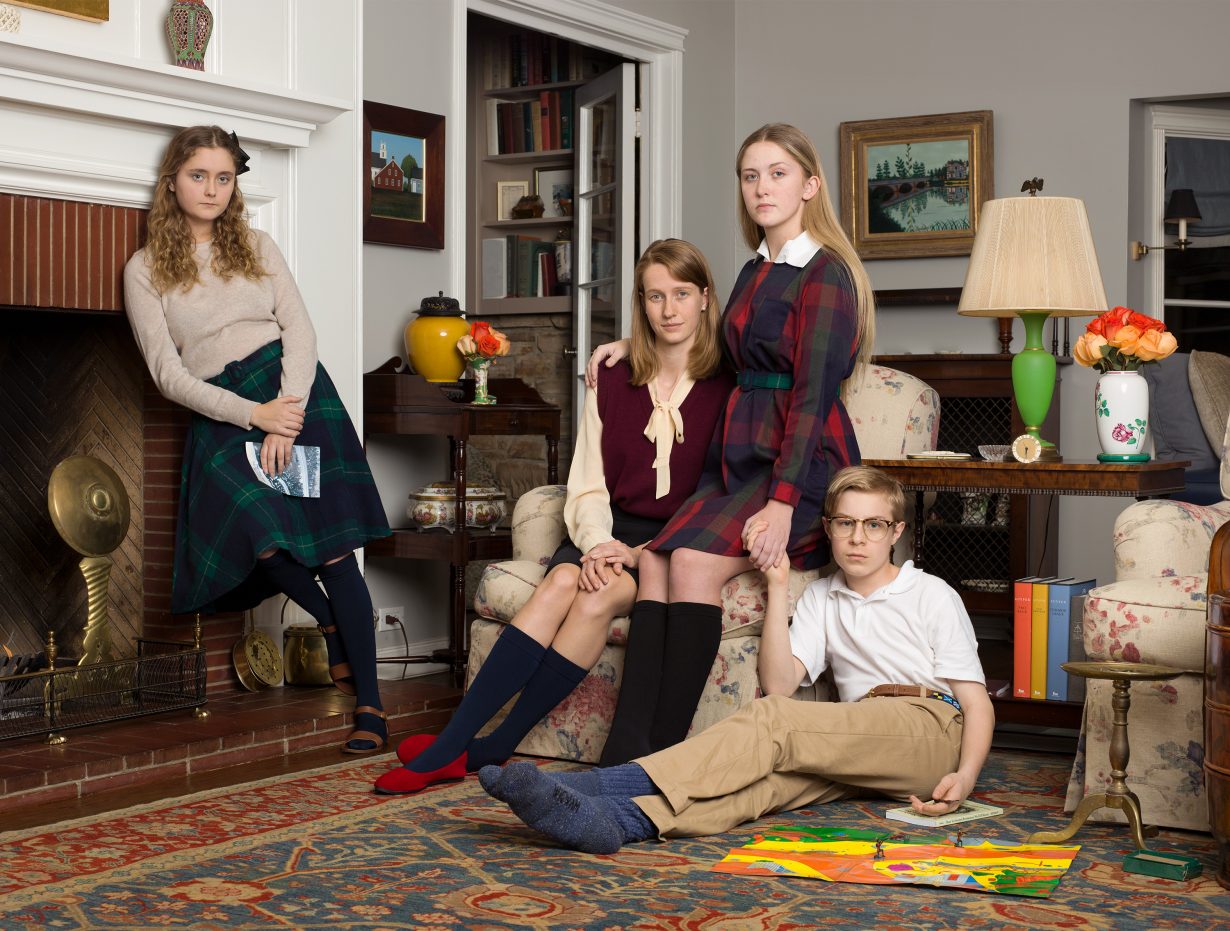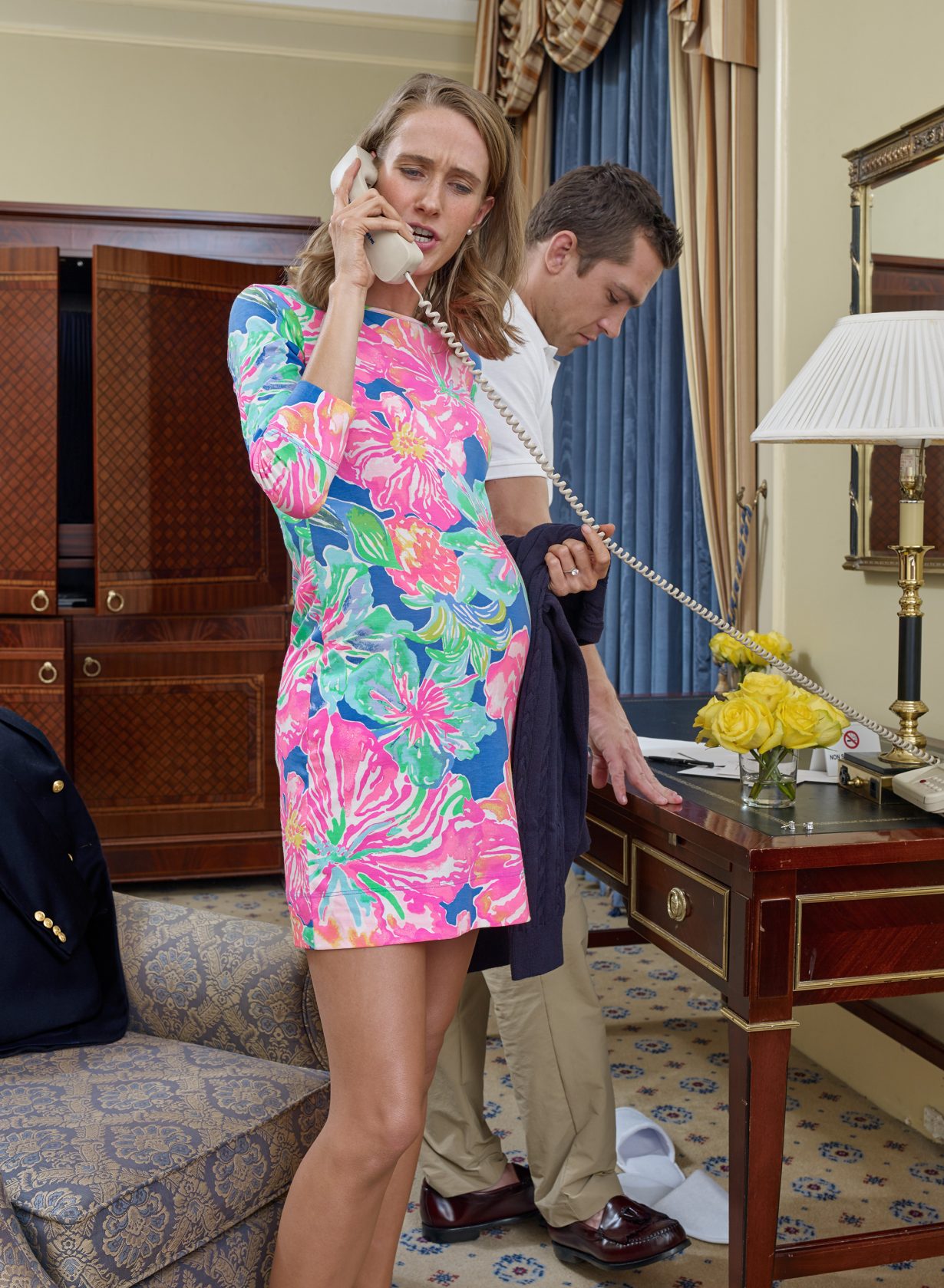Searching for empathy in photographs that capture the codes of the 1% – and how the 99% might see them
The handsome blonde man in the photograph reclines on a wrinkled Persian rug, an arm’s length from the camera. His smiling eyes gaze fondly into ours. Maybe he’s about to say something. But what?
Other details catch the eye: he has one finger in a book – Carl von Clausewitz’s On War (1832) – and he wears a wedding ring. His stone- washed denim shirt is embroidered with the corporate logo of SAIC – ‘An employee-owned company’ – and he sports a rugged-looking digital watch. His forearms are scratched. On the brim of his baseball cap, in permanent marker, is written the word ‘prince’.
What else might you want to know about this picture? It is an artwork by the artist Buck Ellison, currently on view in the Whitney Biennial. Ellison is a Los Angeles-based conceptual photographer who works for the most part in what you might call a commercial idiom: well-lit, immaculately composed and often staged still lifes, portraits and narrative tableaux. The title of this photograph is Rain in Rifle Season, Distributions from Split-Interest Trusts, Price Includes Uniform, Never Hit Soft, 2003 (2021), and it depicts Erik Prince, former Navy seal and founder of military contractor Blackwater, at home on his Wyoming ranch in 2003.
The man in the photograph is actually a professional actor, cast by Ellison for his close resemblance to the young Prince. The work is part of a series titled Little Brother (2021–22), which, through dramatic reconstruction, attempts to flesh out a fuller portrait of a mysterious figure usually vilified by liberals. Prince’s older sister is Betsy DeVos, the Christian conservative billionaire Republican donor appointed by Donald Trump in 2017 as his supremely under-qualified education secretary, a position she used to roll back protections for transgender and BIPOC students, as well as survivors of sexual harassment, all while generally undermining America’s public education system. Prince himself reluctantly entered the public eye in 2007 when Blackwater mercenaries shot and killed 17 Iraqi civilians in the Nisour Square Massacre in Baghdad, injuring 20 others. He receded from view for a while, but later became a shadow adviser to Trump, who returned the favour by pardoning four convicted Blackwater operatives before he left office.


There’s more, though. In 2003, just as Blackwater was receiving its first major government contracts, Prince’s wife, Joan, was dying of cancer. Before she died, Prince began an affair with his children’s nanny, Joanna, who attended Joan’s funeral pregnant with Prince’s child.
In 2003 Prince was thirty-four, the same age as Ellison when he took these photographs, a fact that suggests the possibility of affinity between the artist and his muse – despite Ellison calling him, in the Whitney’s exhibition didactic, ‘a snake in the grass’. Ellison goes on to wonder whether or not ‘a camera allows us to desire, or to be curious, or to feel empathy towards a figure like this’.
Those are three quite distinct impulses, all worth unpacking. Curiosity is the easiest to deal with. As with many members of America’s ultra-wealthy, white upper-classes, there are remarkably few photographs in public circulation of the young Erik Prince. Despite wielding inordinate political power, the Princes (as with dynasties such as the Sacklers, the Kochs, the Mellons and the Rockefellers) use their extraordinary wealth to constrict their public profiles, staying mainly out of sight as individuals even while their family names are everywhere. Curiosity is a natural response.

Empathy is another matter. Ellison has said that he began thinking about empathy as a possible response to his photographs around 2018, when he was making his first depictions of Betsy DeVos. In Dick and Betsy, The Ritz-Carlton, Dallas, Texas, 1984 (2019), a pregnant DeVos is speaking forcefully into a telephone while her husband listens in. Not exactly a likeable character, perhaps, but then likeability is a problematic expectation of powerful female figures. During DeVos’s fraught tenure under Trump, Ellison was struck by the misogyny laced through the vitriol directed at her.
Empathy, it is often said, is sorely lacking in American public discourse. This is by now such a truism that certain provocative thinkers have built careers by arguing against empathy. There’s not much of a case there, except to parse the distinction between cognitive empathy, which allows you to understand why someone thinks and feels the way they do, and emotional empathy, which allows you to feel what they’re feeling – the latter a poor guide, critics say, to reasoned moral decision-making. Plus, it’s exhausting and depressing.
Ellison’s pictures are mainly concerned with cognitive empathy, which he facilitates by an admixture of informational signposting and narrative suggestion. (His photograph Erik with Kitty, Blackwater Training Center, Moyock, North Carolina, 1998, 2019, showing a flak-jacketed Prince cooing over a ginger kitten, is an arch conceit, and an exception.) The density of data within an image such as Fog, In His Light We Shall See The Light, Raintree 23 Ltd Ptnr, Excess Distribution Carryover, If Any, 2003 (2021) is akin to one of Ellison’s still lifes or collages, in which artefacts and print ephemera combine to make a kind of abstract portrait. (His titles, too, are often forms of notational collage.) On the barn wall behind a grinning, shirtless Prince are snaps of military buddies and Thoroughbred horses, a postcard of women in traditional Dutch costume (the Princes hail from a part of Michigan inordinately proud of its heritage), a baseball cap from Prince’s alma mater, Hillsdale College, a private conservative college that has opted out of federal affirmative action policies, and books on the Austrian School of free-market economics.

None of which is particularly appealing, aesthetically or otherwise, except for Prince himself, whose muscular torso offers a visual rhyme with the glossy flanks of the horses behind him. As with so many of Ellison’s images, Fog, In His Light… demonstrates the persistence of desire, even when appended by distasteful circumstance. Long before he pictured Prince and DeVos, Ellison was mining this vein, making images that speak to a viewer’s libido, or avarice, or social aspiration, or reflexive notions of beauty, before disclosing their contextual contaminations – often through the text of their titles. A series of photographs of frothing white surf, Coastal Access Line, Carbon Beach, Malibu, California (2015), was taken on what is known as Billionaire’s Beach, where oceanside mansions have historically blocked public access to the water. Another series, featuring extravagantly healthy vegetables and flowers, actually shows, the photographs’ titles reveal, the gourmet produce of gardens in various California private schools.
Is it satisfying or dismaying to learn that Ellison himself attended one of those schools? His work is not defined by its disdainful identification of some abhorrent ‘other’, but by its description of something, for the artist and for many of his viewers, embarrassingly close to home. In the predominantly white, predominantly privileged contemporary artworld, the (often textual) codes in Ellison’s work speak most clearly to those already proximal to the lives and lifestyles he describes. In his titles, references to investment structures and specialised tax forms might only be fully grasped by the collector class. But that does not mean they are entirely unfamiliar to other viewers. (Ellison commented to me that no one who has visited his studio has ever had to ask what lacrosse is, even though it is played only at a handful of elite boarding schools and colleges.)

While Ellison’s work specifically pertains to a slim demographic of the United States, as with so much American culture it is, on some level, recognisable worldwide. The aesthetic appeal of his photographs is so deeply embedded in the popular psyche that it can easily pass unacknowledged, reinforced by centuries of portraiture of European aristocracy and decades of photos of relaxed white families in bank ads and clothing catalogues.
Ellison’s work fixates on typologies and generalities: the ways in which certain kinds of people look and behave; the ways in which patterns repeat themselves. In Performance Fleece (2018), one of his most austere series, he photographs a hearty blond man modelling a range of fleeces from Vineyard Vines (a brand of ‘preppy casual clothing’ based in Martha’s Vineyard). The tropes of consumer advertising are inseparable from the tropes of class identification and aspiration.
Constancy and repetition are, for Ellison, at once formal strategies and thematic concerns. Again and again, his photographs show us the smiling face of America’s steadfastly enduring structural inequality, an inequality mirrored even in the putatively self-critical structure of its artworld.
